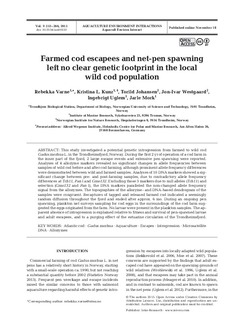| dc.contributor.author | Varne, Rebekka | |
| dc.contributor.author | Kunz, Kristina Lore | |
| dc.contributor.author | Johansen, Torild | |
| dc.contributor.author | Westgaard, Jon-Ivar | |
| dc.contributor.author | Uglem, Ingebrigt | |
| dc.contributor.author | Mork, Jarle | |
| dc.date.accessioned | 2016-02-09T10:16:12Z | |
| dc.date.accessioned | 2016-06-02T08:08:05Z | |
| dc.date.available | 2016-02-09T10:16:12Z | |
| dc.date.available | 2016-06-02T08:08:05Z | |
| dc.date.issued | 2015-11-18 | |
| dc.identifier.citation | Aquaculture Environment Interactions 2015, 7(3):253-266 | nb_NO |
| dc.identifier.issn | 1869-7534 | |
| dc.identifier.uri | http://hdl.handle.net/11250/2391134 | |
| dc.description.abstract | This study investigated a potential genetic introgression from farmed to wild cod Gadus morhua L. in the Trondheimsfjord, Norway. During the first 2 yr of operation of a cod farm in the inner part of the fjord, 2 large escape events and extensive pen spawning were reported. Analyses of 4 allozyme markers revealed no significant changes in allele frequencies between samples of wild cod before and after cod farming, although prominent allele frequency differences were demonstrated between wild and farmed samples. Analyses of 10 DNA markers showed a significant change between pre- and post-farming samples, due to contradictory allele frequency differences at Tch11, Pan I and Gmo132. Excluding those 3 markers due to null alleles (Tch11) and selection (Gmo132 and Pan I), the DNA markers paralleled the non-changed allele frequency signal from the allozymes. The topographies of the allozyme- and DNA-based dendrogram of the samples were congruent. Recaptures of tagged and released farmed cod indicated a seemingly random diffusion throughout the fjord and ended after approx. 6 mo. During an ongoing pen spawning, plankton net surveys sampling for cod eggs in the surroundings of the cod farm suggested the eggs originated from the farm. No larvae were present in the plankton samples. The apparent absence of introgression is explained relative to fitness and survival of pen-spawned larvae and adult escapees, and to a purging effect of the estuarine circulation of the Trondheimsfjord. | nb_NO |
| dc.language.iso | eng | nb_NO |
| dc.publisher | Inter Research | nb_NO |
| dc.rights | Navngivelse 3.0 Norge | * |
| dc.rights.uri | http://creativecommons.org/licenses/by/3.0/no/ | * |
| dc.title | Farmed cod escapees and net-pen spawning left no clear genetic footprint in the local wild cod population. | nb_NO |
| dc.type | Journal article | nb_NO |
| dc.type | Peer reviewed | nb_NO |
| dc.date.updated | 2016-02-09T10:16:12Z | |
| dc.source.pagenumber | 253-266 | nb_NO |
| dc.source.volume | 7 | nb_NO |
| dc.source.journal | Aquaculture Environment Interactions | nb_NO |
| dc.source.issue | 3 | nb_NO |
| dc.identifier.doi | 10.3354/aei00153 | |
| dc.identifier.cristin | 1299980 | |
| dc.description.localcode | © The authors 2015. Open Access under Creative Commons by Attribution Licence. Use, distribution and reproduction are un -restricted. Authors and original publication must be credited. | nb_NO |

